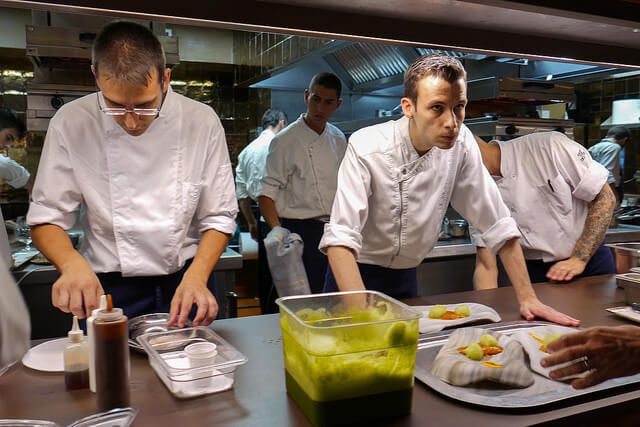Ask any restaurant owner about something they struggle with, and the problem of keeping good employees will make the list almost every single time. The real issues begin when employees don’t stick around very long, leaving owners understaffed and scrambling.
The restaurant industry offers a unique flexibility of schedule that appeals to many. Whether it is the student looking to work when not in class, or the performer looking to subsidize their passion, the industry attracts all kinds of people with unique scheduling needs. That also means that those same employees might not see their job at your restaurant as their top priority. The restaurant industry has an above-average turnover rate. In 2016, the general industry employee turnover rate was 46.1%. In the restaurants and accommodations sector, the turnover rate was at a whopping 72.9% in 2016, up from a rate of 72.2% in 2015, that is a pretty big difference.
Now you might be saying to yourself, ‘Well everyone in the industry has a high turnover rate, that is just how things are. Why should I make changes to improve my retention rate?’
Good question. Other than the immediate struggles of being left understaffed, every time you lose an hourly employee it can cost upwards of $3,500 to hire and train a new one. Now imagine every time someone walks out the door, $3,500 of your dollars are walking out with them. Really puts things into perspective, doesn’t it?
Hiring Employees
A great way to improve your employee retention is by starting at the very beginning, and by that, I mean the hiring process. The first thing is having patience. You may feel like you are in a rush to make sure that all your shifts are covered, but in the long run you will thank yourself for selecting the right candidate and not just the first person to walk in the door.
One of the most common practices in the industry, when looking at a potential employee’s resume, is to hire someone with experience and not consider your company culture. An employee with a positive attitude can be trained to do things the way that you do them, but a bad fit for your culture will always be a bad fit. An employee that is a poor fit usually leaves and ends up costing you money. In that case, you’ll be back to square one, typically with a few bad stories to tell.
Another thing to look at while you have their resume in your hand, is the frequency at which they move jobs. If someone switches places of employment every few months, that is a red flag that they won’t have a problem doing that to you. Take time to consider why they might need to switch jobs so much.
Hiring Managers
 If you are seeking a manager, consider hiring from within your restaurant. Let employees know that you are looking for someone to help with special projects, you may be surprised by the response. Employees you would not have originally considered may be looking to take on more responsibility, while those that seem more likely to jump at the opportunity are happy to stay in their current position.
If you are seeking a manager, consider hiring from within your restaurant. Let employees know that you are looking for someone to help with special projects, you may be surprised by the response. Employees you would not have originally considered may be looking to take on more responsibility, while those that seem more likely to jump at the opportunity are happy to stay in their current position.
Through these special projects, you will be able to determine who is good at doing the work of a manager. If they are not good at the special projects, don’t get upset with them, don’t fire them, simply move them back into the current position without participating in any more different projects. This way you don’t lose an employee, but you are able to determine who can handle the role of manager.
For those that excel, approach them with the idea of becoming a manager-in-training. If they are onboard, start training them for the position. Some will do well, and some might not. For those that don’t, you now have a well-trained supervisor that can handle things on occasion and those who do wow you can now become a manager.
There are many benefits that come with hiring within your company. When you hire from within the company you know the person already fits your company culture, they won’t have to deal with your other employees testing them as a newcomer, and they know how to do things your way. Another benefit is that current employees will see that you promote from within and will have something to motivate them to continue to do their best in hopes of advancing.
You will need to consider the best ways to transition an employee to the manager roll in terms of their coworkers. During your special projects, be sure to observe how they handle having authority over their coworkers, and probably friends. You don’t want them to be a doormat, but you also don’t want them to overcompensate and become too harsh. It is a fine line that needs to be observed.
Training
The training process is a critical time in helping to improve employee retention. It is tempting to pair your new employee with a veteran and leave them to it with minimal supervision. The problem is, if the veteran employee has developed bad habits they could be passing them on to your entire staff.
Train your employees on the correct way to do their job and when. When training, it is also critical to remember that people have different ways of learning. Some learn by seeing, some by hearing, and others by doing. Try to incorporate all aspect when doing your initial training.
If your new employee makes mistakes, don’t immediately jump to the conclusion that they are a bad fit. When something is done incorrectly, retrain them on the proper way to do it. After the third time they make a mistake, you might want to sit down and evaluate whether they don’t know how to correctly complete the task or they simply don’t care.
A consistent orientation process and ongoing training will help to keep all your employees on the same page with the way you do things, creating an overall more pleasant work environment.
The Competitive Edge
 There is always the concern that a well-trained employee might simply decide to work for a different restaurant. A few things can be done to try and convince your staff that your business is the best fit for them.
There is always the concern that a well-trained employee might simply decide to work for a different restaurant. A few things can be done to try and convince your staff that your business is the best fit for them.
The most obvious way to keep employees is by offering them competitive pay with the opportunities for increased pay. Nurture long-term goals and provide the opportunity for advancement. Pay for classes and training, an example of this would be to pay for ServSafe certifications.
Do your best to schedule your employees well. Don’t always give the same employees the slower shifts, and give the occasional shift choice. That being said, we all know that sometimes you can’t make everyone happy, occasionally some people won’t be happy with their shift and that is okay.
Also, don’t underestimate the value of free incentives such as offering a shift meal. It will cost you a little but pales in comparison to the costs of constant hiring and training new employees.
Leaving
Sometimes no matter what you do, an employee is going to leave. This is a great opportunity to have a candid conversation with them about why they are leaving and if any changes could be made to your process to encourage employee retention.
One thing you can do is conduct an exit interview and ask them a few questions about their time with you. A few questions you might like to ask are:
- Why are you leaving?
- What could we have done better?
- What does your new company offer that made you decide to leave?
- Were you comfortable talking to your manager about work problems?
- Were you given the tools to succeed at your job?
- What did you like most about your job? And what would you change about it?
- What was your best or worst day on the job?
Keep in mind with an exit interview that the employee might say some things you disagree with or don’t like hearing. Try to keep an open mind. Don’t argue with the exiting employee. It won’t do either of you any good to end your relationship on bad terms. Most likely you won’t seriously consider making all the changes they suggest but they might be able to give you some insight into a problem or educate you on a problem you didn’t even know was happening.
Retaining good employees is a struggle across the restaurant industry. By taking the right steps during hiring, training, and doing your best to remain competitive as an employer, you can give your restaurant a great foundation for creating a stellar staff and a happy work environment.






